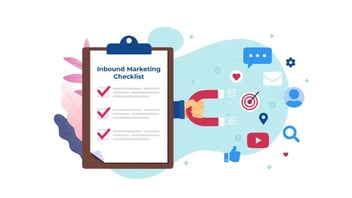Marketing Inbound & Outbound : Collaborer pour le succès
À la lecture des articles actuels, on pourrait avoir l'impression que le marketing entrant est sur le point d'éliminer le marketing sortant (parfois appelé "push marketing") dans la bataille pour les yeux. Nous ne pensons pas du tout qu'il s'agisse là d'une évaluation exacte. Si vous regardez de plus près, vous verrez que beaucoup ont commencé à adopter une approche hybride.
Ils prennent les meilleurs éléments de chaque méthodologie et combinent leur puissance pour améliorer le retour sur investissement de vos efforts de marketing, bien plus qu'aucune des deux approches ne pourrait le faire seule.
Le marketing n'est pas un jeu à somme nulle. Il n'est pas nécessaire de choisir entre l'un et l'autre. Il peut être un "oui, et". En outre, cette nouvelle approche hybride ou "intégrée" présente de nombreux avantages, car les techniques de marketing entrant et de marketing sortant traditionnel fonctionnent très bien ensemble, comme vous le verrez bientôt.
Avantages du marketing entrant
-
Les tactiques sont beaucoup moins intempestives et s'appuient davantage sur l'utilisateur pour prendre l'initiative, ce qui permet de renforcer la confiance, la notoriété de la marque et la crédibilité.
-
Votre stratégie d'Inbound marketing concerne le contenu, l'attention, l'engagement, la confiance et la satisfaction. Tous ces éléments ont un seul objectif : aider les entreprises à entrer en contact avec leurs clients potentiels et à établir un canal de communication bidirectionnel pour augmenter les ventes.
-
Il vous met en contact avec bien plus de données qu'une publicité classique dans un journal. Il vous indique d'où vient votre trafic, le contenu spécifique qui l'a attiré, où il se situe dans le cycle d'achat, et bien d'autres choses encore.
-
Les leads entrants coûtent en moyenne 61 % de moins que les leads sortants. Un contenu exceptionnel est non seulement éducatif pour vos visiteurs, mais il constitue également un facteur essentiel de l'optimisation pour les moteurs de recherche.
-
Il s'agit de responsabiliser les clients potentiels et de passer à des tactiques de marketing qui font une réelle différence dans la façon dont les consommateurs réagissent à une entreprise. L'objectif du marketing entrant est de fournir aux consommateurs les types de contenu qui seront pertinents et utiles.
Avantages de l'outbound marketing
-
Atteindre un public cible plus rapidement. Les campagnes d'outbound marketing permettent aux entreprises d'atteindre un public plus large et d'élargir leur base de clients potentiels par le biais de divers canaux tels que la publicité, l'envoi d'e-mails et les appels téléphoniques.
-
Accroître la notoriété de la marque. Les stratégies de marketing sortant visent à marquer l'esprit des consommateurs en faisant connaître la marque.
-
Génération de leads. Un marketing sortant intelligent peut contribuer à générer davantage de prospects qualifiés en touchant un public plus large et en exploitant de nouveaux segments de marché cibles.
-
Efficace pour différents types d'entreprises. L'outbound marketing peut s'adresser à différents types d'entreprises, telles que les entreprises individuelles et les petites entreprises, car il est facile à mettre en œuvre.
-
Variété de stratégies et de techniques. Les stratégies de marketing sortant comprennent diverses stratégies et techniques, telles que la publicité, l'envoi d'e-mails à froid, le démarchage téléphonique, les salons professionnels et la syndication de contenu, qui peuvent cibler un grand nombre de personnes.
| Marketing sortant | Marketing entrant | |
| Approche | Diffusion de messages à un large public | Attire les clients grâce à un contenu de valeur |
| Tactiques | Annonces télévisées/radio, annonces imprimées, appels à froid, publipostage | Marketing de contenu, référencement, médias sociaux, courrier électronique |
| Perception | Intrusif, interruptif | Utile, centré sur le client |
| Rapport coût-efficacité | Généralement plus coûteux | Souvent plus rentable à long terme |
| Exemples | Panneaux publicitaires, appels de télémarketing | Articles de blog, vidéos éducatives, messages dans les médias sociaux |
Le modèle de marketing intégré combine les aspects les plus performants et les plus efficaces du marketing entrant et sortant. Il s'agit d'un cadre dans lequel tous les aspects du marketing sont regroupés sous un même toit afin de favoriser les conversions, d'atteindre les objectifs de l'entreprise et d'augmenter le retour sur investissement des campagnes de marketing.
Au lieu d'une interruption à sens unique, le webmarketing consiste à fournir un contenu utile au moment précis où l'acheteur en a besoin.
David Meerman Scott
Cette approche hybride s'impose dans quatre domaines principaux : le paiement au clic (PPC), les campagnes d'e-mailing, les envois de contenu et les salons professionnels/événements spéciaux.
Marketing hybride dans les campagnes PPC
Malgré les rumeurs, la publicité par paiement au clic est loin d'être morte. En réalité, elle constitue l'exemple ultime de ces deux méthodes de marketing qui fonctionnent en synergie. La nature même d'une publicité payante est directement tirée du livre de jeu de l'outbound, tandis que le comportement de ciblage est 100 % inbound.
La plupart des plateformes publicitaires modernes (Google AdWords, Facebook Ads Manager) permettent un ciblage avancé. Elles prennent en compte des informations démographiques de base telles que l'âge et le lieu de résidence et y ajoutent une fourchette de revenus, un niveau d'éducation, des centres d'intérêt et bien d'autres choses encore. Ils ajoutent ensuite la possibilité de filtrer en fonction de l'activité sur le site (par exemple, l'appartenance à un groupe Facebook). Ajoutez à cela un filtrage plus classique par mots-clés et vous comprendrez la puissance des techniques d'entrée pour mieux cibler votre publicité traditionnelle.
Pour approfondir ce lien, vous pouvez relier votre annonce PPC directement à une page d'atterrissage pour une offre spéciale connexe ou un élément de contenu téléchargeable, augmentant ainsi les taux de conversion en conduisant les clics directement à un formulaire de collecte de données.
Campagnes d'e-mailing : Tactique sortante soutenue par des méthodes entrantes
Le marketing par courrier électronique se situe dans la même lignée que le marketing entrant et le marketing sortant. La plupart des campagnes sont menées à l'aide de techniques sortantes standard, comme l'utilisation d'une liste de contacts achetée pour envoyer des documents de vente directement aux personnes susceptibles d'être intéressées. Toutefois, comme ces personnes n'ont pas demandé ces informations, le résultat est aléatoire.
En revanche, l'email marketing entrant utilise des prospects qui vous ont volontairement communiqué leurs coordonnées par le biais d'un formulaire, d'une feuille d'inscription ou en s'inscrivant pour accéder à un contenu à accès limité. Ces courriels ont un taux de réussite beaucoup plus élevé, car l'audience a été auto-sélectionnée et se compose uniquement de personnes que vous savez intéressées par votre produit.
Lorsque vous appliquez les meilleures pratiques inbound à vos campagnes outbound, des méthodologies combinées apparaissent. Étant donné que le public n'est pas le même, qu'il s'agit d'un groupe de personnes autosélectionnées et que vous ne savez pas comment votre e-mail va les toucher, il est essentiel d'utiliser certaines techniques inbound pour les mettre à l'aise par rapport à vos intentions :
- Soyez humain
- Fournissez des informations exceptionnelles et utiles dans votre premier courriel.
- Personnalisez votre message ; parlez à l'individu
- Parlez directement de leurs problèmes.
En suivant ces lignes directrices, vous aiderez votre nouveau public à se faire une idée de vous et de votre entreprise en lui donnant un ton amical, sans chichis, et prêt à fournir un contenu informatif fantastique pour soutenir vos activités de vente.
Faites exploser votre contenu entrant à l'extérieur
Votre contenu fonctionne comme un charme, augmentant peu à peu votre portée et attirant de nouveaux visiteurs sur votre site web. Les médias sociaux font connaître chaque nouvel article et engagent votre public avec la voix de votre marque sur plusieurs plateformes de premier plan. Mais vous vous demandez toujours si votre contenu pourrait être plus efficace.
Oui, vos approches de marketing entrant et de marketing sortant peuvent aller de pair et se renforcer mutuellement, car vous pouvez appliquer des tactiques de poussée pour faire passer le mot. Vous pouvez par exemple regrouper plusieurs de vos articles de blog les plus performants dans un livre électronique que vous envoyez à vos listes d'adresses électroniques. Ou bien vous créez une lettre d'information régulière pour vos abonnés, puis vous envoyez une édition spéciale à titre d'essai à cette même liste d'envoi. Des techniques de push correctement appliquées peuvent faire des merveilles pour diffuser votre contenu de plus en plus largement et, ce faisant, gagner de nouveaux abonnés et adeptes.
Les salons professionnels offrent des possibilités uniques de rencontres en face à face
Les salons professionnels et autres événements offrent à vos clients une occasion unique d'interagir directement avec les représentants de votre entreprise. C'est particulièrement vrai dans le domaine du B2B, où vous et vos clients êtes souvent séparés par des États, des frontières internationales, voire des continents entiers.
S'il est vrai que la technologie a beaucoup progressé en termes d'appels vidéo, de webinaires et d'autres communications basées sur le web, il n'y aura jamais de substitut aux interactions en face-à-face pour cimenter les relations. Une étude récente révèle que 46 % des spécialistes du marketing B2B considèrent les salons et les événements comme leur principale source de prospects, de SQL et de MQL.
Les salons professionnels offrent un terrain de jeu fantastique pour expérimenter le mélange de techniques inbound et outbound. Essayez d'utiliser une feuille d'inscription papier pour recueillir les parties intéressées, puis ajoutez-les à votre liste d'abonnés et surprenez-les en leur envoyant un e-mail de suivi réservé aux participants dans les 24 heures suivant la clôture de l'événement. Vous pouvez également placer stratégiquement des codes QR dans votre matériel promotionnel, qui renvoient les participants à une page de renvoi vers un contenu vidéo spécial sur le thème de l'événement. Dans les deux cas, il s'agit de méthodes pratiques de collecte d'informations de contact à ajouter à votre liste de contacts entrants.
Les événements fonctionnent également comme une sorte d'opportunité de " marketing entrant en personne" puisque l'entonnoir est presque identique :
-
Les clients sont attirés vers votre stand par votre matériel promotionnel et la présence de votre marque.
-
Ils ont ensuite l'occasion de s 'engager dans des conversations individuelles avec votre équipe de marketing.
-
Enfin, votre public est ravi que vous le contactiez dans les 24 heures pour faire le point sur son expérience.
Vous n'êtes pas payé à l'heure. Vous êtes payé pour la valeur que vous apportez à l'heure.
Jim Rohn
Ces exemples ne sont qu'un point de départ. Nous avons voulu vous montrer que le marketing entrant et le marketing sortant traditionnel sont parfaitement adaptés pour travailler en tandem. Nous vous encourageons à réfléchir à la manière dont vous pouvez utiliser les pouvoirs combinés de ces méthodes pour travailler pour vous. La combinaison des facteurs peut contribuer à accroître le retour sur investissement de votre marketing numérique et à augmenter les conversions par rapport à ce que l'une ou l'autre de ces méthodes peut faire seule.
Ce contenu est disponible en:
- Allemand: Inbound- und Outbound-Marketing: Wie sie zusammenarbeiten können.
- Anglais: Inbound and Outbound Marketing Strategies: How They Can Work Together
- Espagnol: Inbound y Outbound Marketing: Estrategias complementarias
- Italien: Inbound e Outbound: sinergia per il marketing
- Roumain: Marketing Hibrid: Sinergia Perfectă între Inbound și Outbound
- Chinois: 入站营销和出站营销策略:它们如何协同工作












Commentez ci-dessous